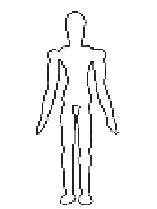Graphics Reference
In-Depth Information
(a)
(b)
Figure 7.24.
(a) The solid human model should be tangent to the 3D region created by back-
projecting each observed silhouette. A distance function can be constructed as the sum of
distances (short, thick lines) between rays from the camera center through points on the sil-
houette and the closest points on the 3D model. (b) An example backprojected silhouette region
for a real image.
approach of fitting body parts of the kinematic model to the visual hull. Kehl and Van
Gool [
236
] computed
D
v
as a weighted sum of squared distances between points on
the model and the closest points on the visual hull. Corazza et al. [
105
] used a variant
of the Iterative Closest Points (ICP) algorithm (see Section
8.4.2
), commonly used for
registering 3D point sets, to compute
D
v
. Vlasic et al. [
520
] took a slightly different
approach of first fitting a kinematic skeleton directly inside the visual hull in each
frame, and then refining a high-quality mesh model
V
(
t
)
based on the skeletal poses
and a skinned model.
7.7.4
Direct Depth Sensing
A final possibility for markerless motion capture is the use of sensors that directly
recover the
depth
or distance to each point in the scene, using either time-of-flight
or structured light technology. We'll discuss such systems extensively in Chapter
8
.In








